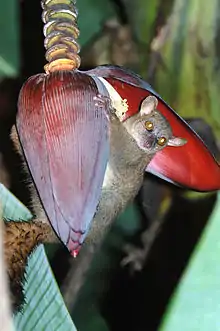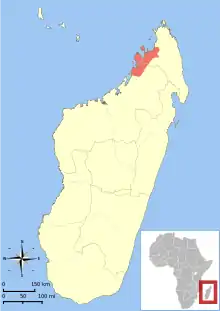Northern giant mouse lemur
The northern giant mouse lemur (Mirza zaza), or northern dwarf lemur, is a species of lemur discovered in 2005.[3] They are part of the primate order, and classified in the family Cheirogaleidae. Previously, both populations of giant mouse lemurs were believed to belong to one species. The northern giant mouse lemurs are small nocturnal lemurs endemic to Madagascar. They weigh about 300 grams (11 oz), and have long, bushy tails and relatively small ears. Their large testicles are an indication of their promiscuous copulation system. These lemurs have been found to use communal sleeping nests including multiple males, which is an uncommon behaviour in lemurs.[4]
| Northern giant mouse lemur | |
|---|---|
 | |
| Scientific classification | |
| Kingdom: | Animalia |
| Phylum: | Chordata |
| Class: | Mammalia |
| Order: | Primates |
| Suborder: | Strepsirrhini |
| Family: | Cheirogaleidae |
| Genus: | Mirza |
| Species: | M. zaza |
| Binomial name | |
| Mirza zaza Kappeler & Roos, 2005 | |
 | |
| Northern giant mouse lemur range[1] | |
Etymology
The word zaza means child in Malagasy. The name was chosen because the northern giant mouse lemur is the smaller of the two giant mouse lemur species, and because of a wish to emphasize the responsibility of the current generation of Malagasy children for the conservation of Malagasy animals for future generations.[3]
Description
The northern giant mouse lemur is relatively small, with juveniles weighing 150 - 199 g, subadults 200 - 249 g, and fully grown adults 250 - 300 g.[5] This species has large testes, among the largest relative testes to body size in the Primate order.[6]
Distribution
The M. zaza are found in a strictly limited region in the north-western part of Madagascar, the Ampasindava peninsula.[7] The habitat is split by two rivers, the Mahavavy River to the north and the Maevarano River to the south. In some areas it is further separated by the Sambirano River.[5] This area in Madagascar has a dry and cool season from May to October, and a wet and hot season from November to April. The species can be found in a transition zone which goes to the Sambirano evergreen rainforest that extends to the north.[8] Home ranges cover 0.52 - 2.34 ha.[5] There is no substantial overlap in home ranges among individuals.[9] An estimated 385 - 1,086 individuals per km2 are present throughout the region.[1]
Behavior
The species has a polygynandrous mating system, likely based on the large size of the testes, which engenders strong sperm competition. Breeding is aseasonal.[6]
The northern mouse lemur is nocturnal, feeding predominantly during the second half of the night. On average, individuals stay approximately 7 meters up in the canopy. During the day they sleep in group-exclusive tree holes. Nesting groups are 2 - 8 individuals in size, made up of both sexes and any age class, and include unrelated males.[5]
Conservation
The species is classified as vulnerable by the IUCN primarily due to loss of habitat.[1] The deciduous forests that they live in are being logged, fragmented, and degraded.[5] The species is listed in CITES Appendix I.[2]
References
| Wikimedia Commons has media related to Northern giant mouse lemur. |
| Wikispecies has information related to Northern giant mouse lemur. |
- Reuter, K.E. & Schwitzer, C. 2020. (2020). "Mirza zaza". IUCN Red List of Threatened Species. 2020: e.T136684A120487592. Retrieved 10 July 2020.CS1 maint: multiple names: authors list (link)
- "Checklist of CITES Species". CITES. UNEP-WCMC. Retrieved 18 March 2015.
- P.M. Kappeler et al.: A New Mirza Species Primate Report 71, July 2005 (PDF)
- Rode, Johanna; Nekaris, Anne-Isola; Markolf, Matthias; Schliehe-Diecks, Susanne; Seiler, Melanie; Radespiel, Ute; Schwitzer, Christoph (2013). "Social organisation of the northern giant mouse lemur Mirza zaza in Sahamalaza, north western Madagascar, inferred from nest group composition and genetic relatedness". Contributions to Zoology. 82 (2): 71–83. Archived from the original on September 23, 2015. Retrieved May 1, 2015.
- Rode-Margono, E. J.; Schwitzer, C.; Nekaris, K. (May 2016). Morphology, behaviour, ranging patterns and habitat use of the northern giant mouse lemur Mirza zaza in Sahamalaza, northwestern Madagascar. pp. 235–254. doi:10.1017/CBO9781139871822.013. ISBN 9781139871822. Retrieved 2 March 2018.
- Rode-Margono, E. J.; Nekaris, K. Anne-Isola; Kappeler, Peter; Schwitzer, Christoph (29 June 2015). "The Largest Relative Testis Size Among Primates and Aseasonal Reproduction in a Nocturnal Lemur, Mirza zaza". American Journal of Physical Anthropology. 158 (1): 165–169. doi:10.1002/ajpa.22773. PMID 26119092.
- Roos, Christian; Kappeler, Peter (2006). "Distribution and Conservation Status of Two Newly Described Cheirogaleid Species, Mirza zaza and Microcebus lehilahytsara". Primate Conservation. 21: 51–53. doi:10.1896/0898-6207.21.1.51.
- Hending, Dan; McCabe, Grainne; Holderied, Marc (October 2017). "Sleeping and Ranging Behavior of the Sambirano Mouse Lemur, Microcebus sambiranensis". International Journal of Primatology. 38 (6): 1072–1089. doi:10.1007/s10764-017-9997-2. PMC 5730628.
- Hending, Dan; Holderied, Marc; McCabe, Grainne (19 July 2017). "The use of Vocalizations of the Sambirano Mouse Lemur (Microcebus sambiranensis) in an Acoustic Survey of Habitat Preference". International Journal of Primatology. 38 (4): 732–750. doi:10.1007/s10764-017-9977-6. PMC 5550550. PMID 28845070.
